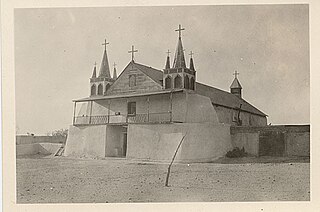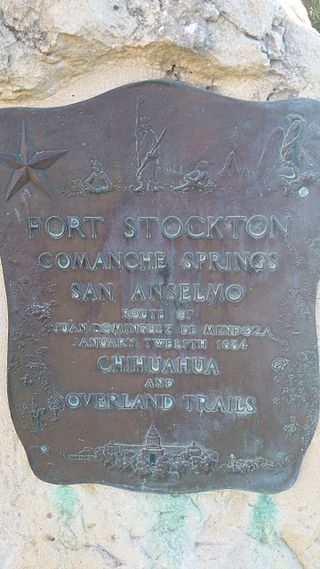The Pueblo Revolt of 1680, also known as Popé's Rebellion or Po'pay's Rebellion, was an uprising of most of the indigenous Pueblo people against the Spanish colonizers in the province of Santa Fe de Nuevo México, larger than present-day New Mexico. Incidents of brutality and cruelty, coupled with persistent Spanish policies that stoked animosity, gave rise to the eventual Revolt of 1680. The persecution and mistreatment of Pueblo people who adhered to traditional religious practices was the most despised of these. The Spaniards were resolved to abolish "pagan" forms of worship and replace them with Christianity. The Pueblo Revolt killed 400 Spaniards and drove the remaining 2,000 settlers out of the province. The Spaniards returned to New Mexico twelve years later.
Estevanico, also known as Esteban de Dorantes and Estevanico the Moor, was the first person of African descent to explore North America. Little is known about his background but contemporary accounts described him as a "negro alárabe" or "Arabic-speaking black man" native to Azemmour, Morocco. In 1522, he was sold as a slave to the Spanish nobleman Andrés Dorantes de Carranza in the Portuguese-controlled Moroccan town of Azemmour.

Mary of Jesus of Ágreda , OIC, also known as the Abbess of Ágreda, was a Franciscan abbess and spiritual writer, known especially for her extensive correspondence with King Philip IV of Spain and reports of her bilocation between Spain and its colonies in New Spain. She was a noted mystic of her era.
Marcos de Niza, OFM was a Franciscan friar and missionary from the city of Nice in the Duchy of Savoy. Marcos led the first Spanish expedition to explore what is now the American Southwest. His report of finding a "beautiful city", "more extensive than that of Mexico [City]", induced Viceroy Antonio de Mendoza to organize a large-scale entrada under the leadership of Francisco Vázquez de Coronado. Marcos served as a guide for this expedition but when they failed to find the wealth they expected, Coronado blamed Marcos, called him a liar and sent the friar back to Mexico in disgrace.

San Agustín de la Isleta Mission, founded in 1613, was a Spanish Mission in what is now Bernalillo County, New Mexico, United States. It was a religious outpost established by Spanish Catholic Franciscans, to spread Christianity among the local Native Americans.

Pueblo of Isleta is an unincorporated community and Tanoan pueblo in Bernalillo County, New Mexico, United States, originally established in the c. 14th century. The Southern Tiwa name of the pueblo is Shiewhibak (Shee-eh-whíb-bak) meaning "a knife laid on the ground to play whib", a traditional footrace. Its people are a federally recognized tribe.
Antonio de Otermín was the Spanish Governor of the northern New Spain province of Santa Fe de Nuevo México, today the U.S. states of New Mexico and Arizona, from 1678 to 1682. He was governor at the time of the Pueblo Revolt, during which the religious leader Popé led the Pueblo people in a military ouster of the Spanish colonists. Otermín had to cope with the revolt with help of the settlers and their descendants in New Mexico, fighting against the Pueblo in some military campaigns and establishing a refuge for the surviving settlers and loyal native Pueblo in the vicinity of the modern Ciudad Juárez, current Mexico.
The Tiwa or Tigua are a group of related Tanoan Puebloans in New Mexico. They traditionally speak a Tiwa language, and are divided into the two Northern Tiwa groups, in Taos and Picuris, and the Southern Tiwa in Isleta and Sandia, around what is now Albuquerque, and in Ysleta del Sur near El Paso, Texas.

Francisco de Ayeta was a Spanish Franciscan missionary of the 17th century, in New Spain.
Alonso de Benavides was a Portuguese Franciscan missionary active in New Mexico in the early part of the seventeenth century.

The National Park System is well endowed to commemorate Hispanic contributions to American society. Some 20 national parklands represent Hispanic heritage in the United States. Some sites remotely display Hispanic contributions to American culture. The National Park System not only preserves the history and contributions of Hispanic Americans, it is also a part of the nation's history. Over the years, the National Park Service has reflected the nation's social history. Among the first Hispanics who influenced the course of the National Parks were:
Jumanos were a tribe or several tribes, who inhabited a large area of western Texas, New Mexico, and northern Mexico, especially near the Junta de los Rios region with its large settled Indigenous population. They lived in the Big Bend area in the mountain and basin region. Spanish explorers first recorded encounters with the Jumano in 1581. Later expeditions noted them in a broad area of the Southwest and the Southern Plains.
The Tompiro Indians were Pueblo Indians living in New Mexico. They lived in several adobe villages east of the Rio Grande Valley in the Salinas region of New Mexico. Their settlements were abandoned and they were absorbed into other Pueblo Nations in the 1670s.

Anton Docher (1852–1928), born Antonin Jean Baptiste Docher, was a French Franciscan Roman Catholic priest, who served as a missionary to Native Americans in New Mexico, in the Southwest of the United States. He served 34 years with the Pueblo of Isleta and was known for defending the Indians.

Gran Quivira, also known as Las Humanas, was one of the Jumanos Pueblos of the Tompiro Indians in the mountainous area of central New Mexico. It was a center of the salt trade prior to the Spanish incursion into the region and traded heavily to the south with the Jumanos of the area of modern Presidio, Texas and other central Rio Grande areas. Its ruins are now part of Salinas Pueblo Missions National Monument.
The Diego de Guadalajara expedition of 1654 was a Spanish expedition dispatched to follow up on the finding of freshwater pearls from pearl mussels in the Concho River in what is now Texas. Although results were disappointing, the expedition led to continued contact with the people of the area and then to Spanish settlement in and around San Angelo, Texas.

Juan Domínguez de Mendoza was a Spanish soldier who played an important role in suppressing the Pueblo Revolt of 1680 and who made two major expeditions from New Mexico into Texas.
Domingo Jironza Pétriz de Cruzate was a Spanish soldier who was Governor of New Mexico from 1683 to 1686, and again from 1689 to 1691. He came to office at a time a large part of the province of Santa Fe de Nuevo México was independent of Spanish rule due to the Pueblo Revolt. With limited resources, he was unable to reconquer the province.
Estéban de Perea was a Spanish Franciscan friar who undertook missionary work in New Mexico, a province of New Spain, between 1610 and 1638. At times he was in conflict with the governors of the province. He has been called the "Father of the New Mexican Church".

The Province of Las Californias was a Spanish Empire province in the northwestern region of New Spain. Its territory consisted of the entire U.S. states of California, Nevada, and Utah, parts of Arizona, Wyoming, and Colorado, and the Mexican states of Baja California and Baja California Sur.









